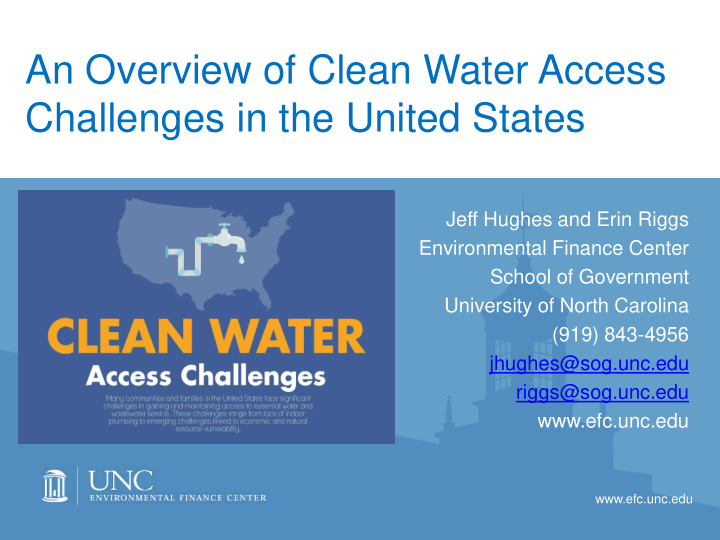



An Overview of Clean Water Access Challenges in the United States Jeff Hughes and Erin Riggs Environmental Finance Center School of Government University of North Carolina (919) 843-4956 jhughes@sog.unc.edu riggs@sog.unc.edu www.efc.unc.edu www.efc.unc.edu
Supporting the fair, effective, and financially sustainable delivery of environmental programs through: • Applied Research • Teaching and Outreach • Program Design and Evaluation How you pay for it matters 2
Outline • Background • Summary • Today’s Challenges • Tomorrow’s Challenges • Customizing Responses and Initiatives
Spoiler Alert: Take-Aways • The nature of access challenges is as fragmented and diverse as the water service provision models >> customize your solutions • Many access challenges are magnified by “isolation” >> identify and address isolation (e.g. allow for rate revenue funded CAP) • More precise assessments are hindered by available information and data >> improve your data • Success initiatives almost always involve partnerships
Framing and Categorizing Access Challenges • By SDG goals • Today vs. tomorrow • Drinking water vs. wastewater vs. water in the environment • Community level vs. household/individual property level • Environment vs. Technology vs. Governance vs. Economic • Geographic • Urban vs. rural • “Responsible” parties and partners • …….
United Nations Sustainable Development Goal 6: Ensure availability and sustainable management of water and sanitation for all 6.1 Provide access to safe, affordable drinking water for all. 6.2 Provide access to adequate, equitable sanitation and hygiene for all. 6.3 Improve water quality by reducing pollution, dumping, and release of hazardous chemicals and materials. 6.4 Increase water-use efficiency and reduce water scarcity. 6.5 Implement integrated water resources management at all levels. 6.6 Protect and restore water-related ecosystems. • 6.a: Expand international cooperation and capacity-building support to developing countries in water- and sanitation-related activities • 6.b: Support and strengthen the participation of local communities in improving water and sanitation management
TYPICAL ANNUAL BILL FOR WATER AND WASTEWATER SERVICES
POVERTY RATE BY STATE
PERCENTAGE OF EACH STATE SERVED BY A SMALL WATER SYSTEM
Fast Moving Storm
Fair Bluff, NC
Slow Moving Storm Number of W01 water bills 600 500 400 300 200 100 0 2002-01 2003-01 2004-01 2005-01 2006-01 2007-01 2008-01 2009-01 2010-01 2011-01 2012-01 2012-12 2013-12 2014-11 2015-11 2016-12 PRELIMINARY RESULTS
Slow Moving Storm
DISCUSSION, QUESTIONS, COMMENTS….
Panel Findings and Recommendations • “Fragmented Governance” • “Varied viewpoints” • “Bifurcated regulatory and organizational structures.” • “separately-managed silos for drinking water, wastewater, and stormwater at all levels of government.”
Paying for water and wastewater services in the United States • Highly fragmented and decentralized with local government, non-profit, and for-profit service providers • Federal legislation drives most environmental regulations/costs • Federal government incentivizes private lending through interest tax exemptions and provides project level funding assistance to utilities through variety of federal programs 32
Paying for water and wastewater services in the United States (Continued) • State governments establishes economic regulatory framework – In most states, government/non-profit rate authority at local level and for-profit rate authority under state regulatory commissions • Variation in state government involvement in project level funding • Customer assistance programs primarily implemented at utility level with very limited federal or state involvement 33
General Types of Strategies • Reduce cost of projects for a system (grants, loans, project delivery mechanisms) • Reduce costs of providing service to all customers (asset management, consolidation etc.) • Reduce amount of water that is used • Reduce bill payment for subset of customers (Customer Assistance Programs)
Navigating Legal Pathways to Rate- Funded Customer Assistance Programs https://efc.sog.unc.edu/pathways-to-rate-funded-customer- assistance
Non Commission Regulated Utilities : Ability to Implement CAPS Funded by Ratepayer Revenues by State Podcast: http://thewatervalues.com/2017/10/17/customer-assistance-programs- expanding-importance-stacey-isaac-berahzer/
Moving beyond “percent MHI”… • Most used and most critiqued metric • Historic focus on what the “median” person pays for water as a percent of income • Metric has been used beyond what it was meant to be used for….
Water and Wastewater Residential Rates Affordability Assessment Tool On the EFC Website Go to http://efc.sog.unc.edu and search for “Affordability Assessment Tool” Free, simplified Excel tool allowing you to examine several metrics to assess how affordable your rates are in your community
Conclusion • The nature of access challenges is as fragmented and diverse as the water service provision models >> customize your solutions • Many access challenges are magnified by “isolation” >> identify and address isolation (e.g. allow for rate revenue funded CAP) • More precise assessments are hindered by available information and data >> improve your data • Success initiatives almost always involve partnerships
For More Information Jeff Hughes or Erin Riggs Environmental Finance Center University of North Carolina at Chapel Hill jhughes@unc.edu or riggs@sog.unc.edu www.efc.unc.edu
Recommend
More recommend